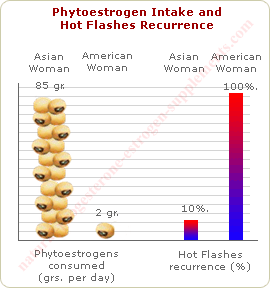34 MENOPAUSE SYMPTOMS |
HEALTH CENTER |
|
LEARN MORE |
|||||||||||||||||||||||||||||||||||||||||||||||
| Menopause | |||||||||||||||||||||||||||||||||||||||||||||||
| Symptoms | |||||||||||||||||||||||||||||||||||||||||||||||
| Herbs for Menopause | |||||||||||||||||||||||||||||||||||||||||||||||
|
|||||||||||||||||||||||||||||||||||||||||||||||
|
|||||||||||||||||||||||||||||||||||||||||||||||
|
|
|
Phytoestrogenic Herbs as a Replacement for Traditional Estrogen Replacement Therapy |
|
Estrogen replacement therapy (ERT) has been used for more than 25 years. Results of ERT studies show that estrogen therapy alone can be used to prevent cardiovascular diseases to reduce osteoporosis risk and to relieve menopausal symptoms. However, ERT also has side effects including a potential increase in the risk of breast cancer and an increase in vaginal bleeding. Too, there is an increased risk of endometrial cancer if women with an intact uterus take unopposed estrogen therapy.
That is the reason why more and more women are looking for natural alternatives like phytoestrogenic herbs. Phytoestrogenic herbs naturally contain a diverse group of nonsteroidal plant compounds that can behave as estrogens. However, they are much weaker than human estrogens, with 102 to 105 times less activity. In most phytoestrogenic herbs, the isoflavones are the most potent compounds. In fact, are more than 1000 types of isoflavones, but the most commonly investigated are genistein and daidzein, which are also thought to have the highest estrogenic properties. They are found in legumes such as soy, chickpeas, clover, lentils, and beans. |
|
The way phytoestrogenic herbs act in our body varies from person to person, and there is also a sex difference, with women appearing to metabolize them more efficiently. The estrogenic activity of the various isoflavones varies greatly. Medical specialists do not yet know which one is the most biologically active form.
Observational studies discovered the rich-in-phytoestrogenic herbs diet of middle age Asian women was the main cause for their lack of hot flashes and other menopausal symptoms. It was also pointed out that the most significant eating habit is the high quantity of soy. Soy contains high levels of isoflavones, which may account for raising the natural declination of estrogen hormones produced by the changes of menopause. As a result of these observational studies, isoflavones are marketed as food supplements and drinks, and also as nonprescription-requiring natural hormone replacement therapy. |

Cases of hot flashes in Asian women represent only 10% of the total in American women. |
It is possible that by supplementing the diet with phytoestrogenic herbs we can improve disease profiles which involve estrogen imbalance. Herbs traditionally recommended for menopausal symptoms include black and blue cohosh, red clover, evening primrose oil, chasteberry, among others.
However, it is reported that 70% of the patients who use complementary therapy do not reveal this to their "traditional" primary care physician because they either do not consider it a medicine or fear primary care physician disapproval. When deciding to take complementary therapies, patients frequently base their decisions on anecdotal reports of success in the lay literature more than information from scientific experiments. Many women who are unwilling to take traditional ERT see herbal therapies as natural and, therefore, preferable to "unnatural" prescription medication, despite the fact that traditional ERT is often derived from natural sources such as mare's urine. Herbal and plant-derived therapies are frequently considered safer, although there are no government standards controlling their quality. While herbal supplements may be effective, they may also be dangerous, mixed with contaminants, or have unknown or adverse effects. A recent review article on these herbs and supplements reveals that the scientific evidence is scant regarding their safety and efficacy. Few randomized controlled trials have been done investigating their use and these trials show that none have proved better than placebo. Some small studies examine the role of phytoestrogenic herbs in the prevention of menopausal symptoms. Evidence for the potential health benefits of phytoestrogenic herbs is increasing. However, the clinically proven health benefits of prescribed ERT far outweigh those of phytoestrogenic herbs. Therefore, there is insufficient evidence to recommend the use of phytoestrogenic herbs in place of traditional ERT, or to make recommendations to women about specific phytoestrogenic herbs. Written by: Natural-Progesterone-Estrogen-Supplements.com
Sources: Gina Glazier, M.D. & Marjorie Bowman, M.D. "A Review of the Evidence for the Use of Phytoestrogens as a Replacement for Traditional Estrogen Replacement Therapy" Published in JAMA Magazine Vol. 161 No. 9, May 14, 2001. |
| Back to Home: | 34 Menopause Symptoms |  |
